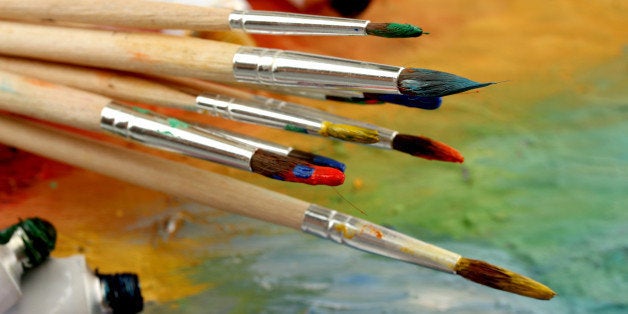
The arts and humanities might be going through a rough patch, but if you ask the Millennials they can tell you that disciplines such as classical music, visual art and fiction are alive and well. You may not find them living and breathing in your museum or symphony halls, in hard cover books or on century-old canvases -- but you might discover that their hearts are now beating to the bits and bytes of a new tempo.
Take for example Morgan, a student who took my Global Remix Culture class at Union College. She opened my mind to a new world of classical music as energized by groups like The Piano Guys. This American musical group, which includes a pianist, cellist and studio engineer -- not Millennials, but GenXers, by the way -- have been mashing up classical and contemporary tunes, such as Beethoven's Fifth Symphony and One Republic's song "Secrets." The result? One energetic and coherent composition called "Beethoven's 5 Secrets." And what is their compositional secret? Not to isolate, but to visually and viscerally elevate both classical and popular music through video mash-ups of piano and cello performances located in outdoor spaces including glaciers, canyons, and before the seven great wonders of the world. The result is a deeply moving, beautiful and infectious musical energy filled with a joy for composition and consumption that reaches across spaces and crosses generations.
Adding to this remixed appreciation of classical music in settings that inspire and uplift is the work of Lindsay Pollack, who began as a Rennaissance flutemaker in the 1970s and now creates different types of instruments through household items such as carrots and hoses. The rubber glove bagpipe or carrot flute are perfect examples of how Pollack, among others, inspire a new love for classical music among the young, admits Morgan, by personalizing the experience of, well, quite literally making music.
Classical art is no exception to the Millennials' embrace of a remixed and personalized culture centered on the arts and humanities. Another student in my course, Allison, shared with the class the cover of "ARTPOP" (2013), in which a sculpturized image of Lady Gaga is giving birth to a gazing blue ball before Sandro Botticelli's 1486 painting of "The Birth of Venus." The effect of this còllage created by American artist Jeff Koons (b. 1955) not only aligned the singer with the visual art world, but it also led to a new appreciation of high art that not only demanded extensive historical and visual knowledge, but particular interpretive skills needed to analyze the joining of three times (that of Botticelli, Koons and Gaga), three worlds, and three cultures.
Based on the analytical skills needed to interpret today's multimedia and multi-spatial and temporal worlds, Allison, who is an Art History major, is disturbed by the negative messages she and her classmates have received since childhood for their educational careers. Apart from the cuts to programs that removed opportunities in art, music, theater or dance from elementary to high school, the social attitudes she still has to face when asked questions such as: "What are you going to do with a degree in Art History?" and "Why not get a more useful major or minor?" deeply concern this young woman. But what she understands better than many adults is that the arts and humanities today are intrinsically connected to the everyday consumption, creation and sharing patterns of the Millennials. And that, in an ever-changing job market, her Liberal Arts degree in Art History will ultimately provide more opportunities than a profession-oriented degree, as has been well-documented by the American Association of Colleges and Universities, among others.
Allison understands that Millennials are customizing the arts in ways that allow them to document, share, and remix. For instance, she creatively defines Instagram's user profile as "a personal exhibit space" which tells a story through images and tags and which have led to gallery and photo competitions. In other words, the worlds of personalized, amateur creation are increasingly feeding into high art environments. She also understands that museums, galleries, theaters, musicians and artists use Instagram as a way to promote themselves and connect with others. The world of high art and customizable personal impressions are increasingly intersecting in spaces that expand and move beyond large stone buildings.
Today's visual and verbal culture is exploding out of the spaces and containers traditionally assigned to their existence and value thanks to the technologies and databases at the fingertips of us all. This is just one reason why the value of the arts and humanities cannot be measured by degrees awarded or money earned out of college. The thousands of fan fiction sites alone demonstrate the breadth and strength of today's artistic expression and storytelling possibilities. For this reason, Morgan, Allison and their classmates need, more than ever, the knowledge and training to become perceptive consumers, interpreter and producers of their remixed worlds.
This does not mean less support and education of the arts and humanities, less development of deep critical and interpretive thinking, less training of quality artistic products, fewer resources for the development of communication skills and dwindling support for the deep knowledge building and research skills derived from classes in Art History, Literature, or Music. On the contrary, it means that we need much, much more support for our young, lest we fall into a culture of amateurism, superficiality and blind following of trends and propaganda.
So let's stop talking about the death or decline of the arts and humanities. Let's explicitly engage with its rebirth. Let's keep an eye on the Millennials and let's give them the support and training they need to lead the way.